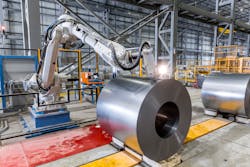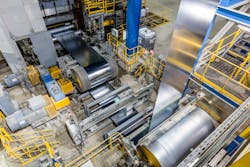US Steel Bets on Mini-Mills, EV Motors for Near-Term Sustainability
Pittsburgh-based U.S. Steel Corp. has a goal of being emissions net zero by 2050. We talked with the company’s chief strategy and sustainability officer, Richard Fruehauf, about how the steelmaker plans to achieve those targets, and found that USS has a solid plan in progress to make a 20% reduction in those emissions by 2030. Admittedly, the picture becomes hazier for the 80% after that, depending on groundbreaking energy discoveries that have yet to be made and technologies that today are exploratory.
Fruehauf has helmed USS's strategy for the past five years. In 2021, “sustainability” became part of his nameplate. We talked with Fruehauf about the steelmaker’s sustainable steel and electric mill projects—including a flex mill in Big River, Arkansas, that combines integrated and mini-mill steelmaking—and specialty steel for electric-vehicle motors. The conversation also touched on the innovation and partnerships that need to be happen to hit net zero in the next 27 years.
IndustryWeek: Your title got longer in 2021. You went from chief strategy officer to chief strategy and sustainability officer. What the significance of those extra words?
Richard Fruehauf: We did that intentionally as a company because our sustainability program is completely intertwined with our overall business strategy. At a lot of companies, in my experience, sustainability is a separate silo or it's bolted on—sort of done on top of or in addition to the overall company business strategy—but that's completely not the case and we do see the two as completely intertwined and they dovetail very nicely. Our priority from a sustainability perspective has been to transition our steelmaking process to be much more climate-friendly.
To do that we set some metrics and we've been transparent in disclosing our performance against those metrics. We set a net zero goal by 2050, the first North American headquartered steel company to do that. We had previously set a goal in 2019 that we would reduce our greenhouse gas emissions intensity by 20% by the year 2030. And we were using 2018 as a baseline. That's a calculation of how much greenhouse gas you emit per ton of steel produced. So we're tracking very well to achieving that goal by 2030. We're not there yet, but we're doing quite well. On our website, we have what we call our Roadmap to 2050, and it shows the steps we think we will take.
Future [electric] mini-mill development is something we're doing from a business strategy perspective, but it also has a huge impact on our greenhouse gas emissions. The average ton of steel produced from the mini-mill route versus the blast furnace route has about 25% as much greenhouse gas emissions, so you can make a huge dent in your greenhouse gas emissions just by moving toward a mini-mill, which is electric arc furnaces melting down scrap steel.
Are traditional blast furnaces able to be converted to mini-mills, or do mini-mills have to be new construction?
An electric arc furnace and a blast furnace are very different technologies. The blast furnace operates on—basically, you're heating up coal, right, that's what coke is. It's just purified coal, and you're dropping it into this giant pressure vessel, the blast furnace, and you’re putting iron ore in there, and the coke and you’re super-heating it. So you’ve got iron ore, you’ve got coke. You’ve got a little bit of limestone and you put it into this giant tank and you drop it into this giant pressure vessel, the blast furnace, and it’s dropping down through this process where it’s under tremendous heat and you’re blasting it with oxygen.
The coke, that's just carbon. And it grabs the oxygen molecule in the ion to purify the iron and that's carbon dioxide. That's a greenhouse gas. So that's why you end up with all the greenhouse gases from the blast furnace.
The beauty of the electric arc furnace processes is it’s a very different technology. Really, you're taking old steel. You're taking old cars, old washing machines that are at the junkyard and have been chopped up and you're putting it into this furnace, and you're blasting it with electricity. It’s like a lightning bolt. Literally. It’s massive amounts of electricity. And it liquefies that old steel, that scrap steel. And the beauty of steel is no matter how many times you recycle it, it's as good as new. It doesn't lose any of its properties. It doesn't become weaker. It's as good as that. So that technology is obviously very electricity-focused, whereas a blast furnace doesn't have a lot of electricity flowing into it. This natural gas heating of the coal, the coke and the iron ore and that pressure vessel, it’s a very different technology which makes it not feasible to convert the blast furnace.
So it's part of the plan to retire the blast furnaces by 2050? Or will some of those still be relevant?
We’re looking at more electric-arc furnaces because that's a proven way to reduce greenhouse gases. The challenge with blast furnaces is there are paths theoretically to reduce the carbon emissions from a blast furnace and so we're looking at some of those. But unlike electric-arc furnaces, you need the technology to take that blast furnace and stop the greenhouse gases from coming off that chemical reaction. The question is, can you capture it? And then what do you do with it? And so for blast furnaces, what needs to happen is technology needs to mature in terms of, “Can you take the carbon the CO2 and the other greenhouse gases, grab them, and then what you do with them?” So you see the federal government and others looking at stimulating carbon capture and sequestration or carbon reutilization. So we've we've announced a number of projects, but the technology needs to mature.
What you see in our roadmap is: Invest in the proven technologies in this first 10 years—electric arc furnaces with renewable or nuclear power. Continue to evaluate and work with others to see what technologies might evolve and mature so that we can make informed decisions and make a big bet on, say, if somebody's come up with a carbon capture and sequestration technology that we feel confident will work and it's economical.That's why we've tried to segment or spread across that 30 years the different approaches we're taking to the different steelmaking technologies, because you're talking hundreds of millions of dollars of capital to invest in a blast furnace. You want to know that that technology is going to work. So we're working with others. We've announced a memorandum of understanding with a company called CarbonFree. Their technology takes the greenhouse gases that come off of a blast furnace and can convert it into reusable products. In this case, I think they converted it into precipitated calcium carbonate and synthetic limestone. Now, that technology, it's not our technology. This is a partner we're looking to work with. It's a technology that needs commercialization, right? And so we're interested in looking at it but we're not ready yet to make a big bet and say, “Okay, we're going to put this technology in all our blast furnaces because nobody's done it yet.” We don't know how well it'll perform or what it will cost.
So that's what we're looking at in terms of the blast furnaces. The Department of Energy has funded a project with the University of Illinois to test what's called direct air capture at our Gary Works. The CarbonFree project is also in our Gary Works.
What's the big deal about U.S. Steel’s new facility in Arkansas?
It's our subsidiary called Big River Steel. We bought Big River steel in two phases. In 2019, we closed on an acquisition of 49.9% to buy Big River and we had the ability to fund the remaining 50.1%. We exercised that option in January 2021.
Big River Steel at that point made 3 million tons of steel for this electric arc furnace route. After we worked on that deal—I worked on that deal—we then decided in late 2021 that we wanted to expand and build another 3 million ton electric arc furnace mini-mill facility. So we did a site selection process. And we decided that Big River in Arkansas could support a doubling of capacity. So we call that second mini-mill BR2. It's basically in Osceola, Arkansas, right on the Mississippi River. You'll see this massive construction project. So you've got the existing facility, already producing steel 3 million tons a year. And then we're going to double the capacity by putting in two more electric arc furnaces and new casting and rolling technology, called endless casting and rolling, which is very efficient. It’s the first time it will be installed and used anywhere in North America. And when that is done next year, we'll be able to produce 6 million tons.
We also have projects underway to produce electrical steel.That electrical steel project should be coming online later this year with special finishing lines. It will produce Indux, which is our brand name for electrical steel. That Indux steel is critical for electric vehicles. A lot of people talk about the battery technology you need for batteries for electric vehicles, which is all true. But you’ve got to be able to take that, store electricity in the battery and convert it into motion in your electric vehicle. And to do that you need an electric motor, which is one of the critical elements in electrical steel and we have very limited supply in the U.S. of electrical steel. So that facility, that line, that Indux product we're going to be making at Big River will be key to the ability to make electric vehicle motors.
And another type of steel is also produced in Arkansas.
Verdex is our brand name for low-carbon-emission steel made through the electric arc. Every time your auto companies say we're going to lower our carbon footprint, well, guess who they come running to? They talk to their supply chain and we're the first people they come to and say, “Hey, you've got to lower your carbon footprint for all that steel you're supplying to us.” And so we’re trying to make the same kinds of steel that we would make through the blast furnace process, but make it through the electric arc furnace mini-mill process.
Does sustainable steel raise the price of the vehicle; is there a cost issue right now?
I don't know how they're going to price the vehicle—we’re talking to customers about the right price point for Verdex. But when you look at values, using myself as an example, I don't own an electric vehicle. But my understanding is if you were gonna go buy an electric vehicle, the price point for entry is about $60,000 to $65,000 for the low-end EVs, right? The cost of the steel that goes into a vehicle that price point is a rounding error—a very small portion of the overall cost of building any vehicle.
If I were marketing, electric vehicles, my demographic of customers is very interested in having a climate-friendly vehicle and would be willing to pay a little more to know not only is it an electric motor, and no internal combustion engine, but that the steel that is on my vehicle was made in a much less carbon-intense way.
Will Verdex be used exclusively on EVs?
Absolutely not. We see demand for coming not just from the automotive sector—it can go into any number of products. We supply into the appliance industry, we get into HVAC systems, we supply steel that goes into packaging. And so we think that as manufacturers increasingly tried to respond to their customer tastes and demands their investors, we see opportunity for Vertex to go into a variety of areas—in construction. Think of a LEED-certified building. You certainly would want low-carbon-emission steel in the materials that go into the building.
How quickly are you able to scale up the production of sustainable steel?
We can certainly produce Verdex, as we're doubling that capacity. In terms of Indux, the facility that's coming online later this year to make the electrical steel, when it hits run rate, will probably be around 200,000 tons a year. The demand is increasing with electrification, and there's only one other electrical steel producer in the U.S. today. At Big River, we’ll have the ability to make ultra-thin gauges of this electrical steel, which is important from a magnetic electrical [conversion] perspective. It makes it a better motor to be able to make those ultra-thin gauges of steel. We see a lot of opportunity there.And then there’s reshoring. The USMCA has new rules of origin. There's also a huge amount of interest from customers to make sure their supply chains are secure. And we’ll be able to say, “Hey, listen, our steel is mine-melted and poured in the USA, so you don't have to worry about shipping delays crossing the Pacific or the supply chain disruptions that we saw coming out of COVID.” I like to say, everybody's talking about reshoring. We never left—we don't need to reshore. We've always been here in the USA.
What do you see as your biggest challenges to reaching your sustainability targets?
The real issue, from my perspective, is the power. You can have electric-arc furnaces but you still need an electricity source that's not emitting lots of carbon. We have a great relationship in Arkansas with Entergy, the utility. They've actually acquired a 250 megawatt solar field called the Driver Project that's going to power a lot of the electricity needs of Big River in addition to nuclear. So our main challenge is just making sure that we have access to that low-carbon-emission, electricity power generation. And I think if we do that, and we stay focused on getting our Big River facility on time and on budget, we should be in good shape. The 2050 goal is a lot longer and a lot harder. We’ll have to assume that there will be sufficient sources and amounts of non-greenhouse-gas-emitting power. We certainly need to see carbon capture and sequestration technology mature. We also may need to see hydrogen developed as a source of energy for us in the production of iron ore. We’re not an energy company and we don’t produce chemicals. We're a steel company. So we're going to need partners, and we're going to need business models and favorable government policies that will encourage the development of those key inputs and technologies so that we can get to that 2050 goal.
***To comment on this article, please scroll down past story recommendations to "Voice Your Opinion."
About the Author

Laura Putre
Senior Editor, IndustryWeek
As senior editor, Laura Putre works with IndustryWeek's editorial contributors and reports on leadership and the automotive industry as they relate to manufacturing. She joined IndustryWeek in 2015 as a staff writer covering workforce issues.
Prior to IndustryWeek, Laura reported on the healthcare industry and covered local news. She was the editor of the Chicago Journal and a staff writer for Cleveland Scene. Her national bylines include The Guardian, Slate, Pacific-Standard and The Root.
Laura was a National Press Foundation fellow in 2022.
Got a story idea? Reach out to Laura at [email protected]



